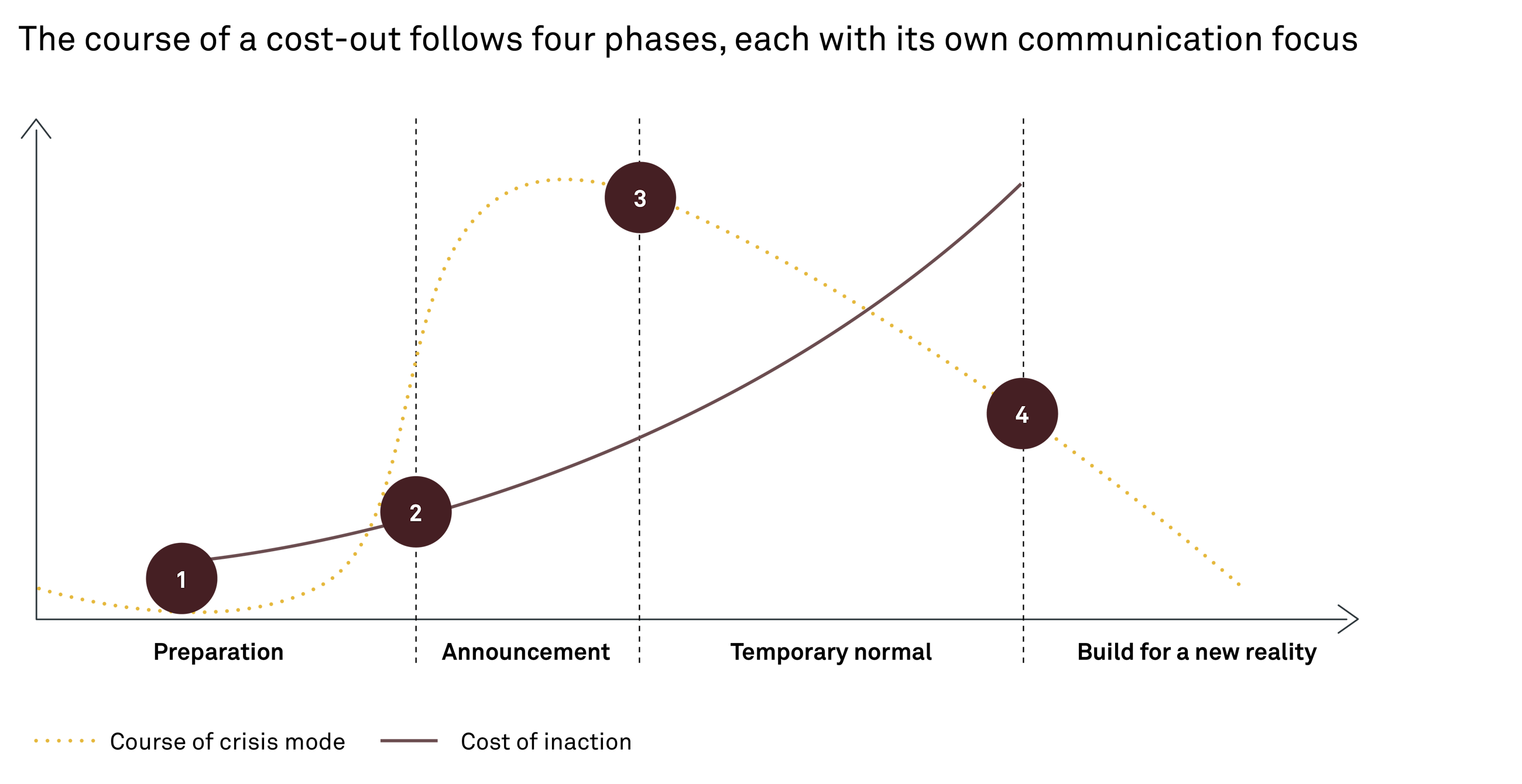Article
How you communicate with your organisation will define your leadership team and shape your community for the long term.
Published
30 October 2025
Ask your people what defines your culture, and they will not point to a mission statement or values on the wall. They will, however, point to how leaders and colleagues acted the last time the organisation faced resistance. How you communicate during times of hardship is what people will remember, and what will define your culture for years to come.
Cost-out is back on the agenda.
Many companies are reducing the permanent cost base to protect their ability to compete. Outsourcing, downsizing, automation, and process simplification are just some of the tools used to strengthen the business. Everything is planned down to the last detail. Every penny taken into account. All options considered.
There’s only one problem. What management sees as a financial gain to strengthen the business is perceived as a threat by the organisation. Rather than the window of opportunity it represents.
Financial win vs. cultural risk: Tell the right story
If not communicated properly, what should be an exercise in getting your organisation up to speed ends up pushing people into survival mode. Trust fades. Motivation falls. Doubt emerges across employees, partners, and customers. In other words, how you communicate when the going gets tough will define your culture and performance for years to come.
The good news is: there is another way. Communicating a tough cost-out is like walking a knife edge, between spreadsheets and people, between rationality and emotions.
The anatomy of a cost-out
A cost-out is a disciplined response to real market pressures, not a crisis manufactured by leadership. Unlike an immediate crisis, a cost-out can be planned and staged deliberately. Act accordingly: plan tightly, coordinate fast, and follow through consistently. Emotions run hot even when the logic is sound, so work with a clear structure that enables disciplined planning, rapid coordination, and consistent execution.
The four phases of cost-out communication
- Preparation
The organisation brings the facts together, locks the scope, and aligns leadership on intent and boundaries. The narrative, timelines, and governance are settled. Interdependencies are mapped, and market, media, and stakeholder monitoring is in place. This ensures the company speaks first, from a single source of truth. - Announcement
The decision lands, publicly and personally. The core story, near-term shifts, and available support are laid out. External narratives start forming in press and social, while internal reactions build in parallel. - Temporary normal
Questions spike, rumours surface, and small operational wobbles appear. Managers handle case-by-case impacts, clarifications and decisions flow regularly. Early signals of continuity and progress are made visible to steady the temporary normal. - Build for a new reality
The dust settles. Narrative shifts from a state of emergency to one of possibility. New cost structures, roles, teams and ways of working take hold. Contribution routes open and tracking savings and shifting capabilities become routine. The organisation shows how the changes protect jobs, customers, and competitiveness. Confidence returns as the new reality sticks.
Below are our five principles based on our experience helping organisations communicate cost-outs, recover fast, and emerge stronger from times of hardship.
5 principles for cost-out communication
- Tell the story, then let the numbers speak
Spreadsheet logic doesn't apply well if you are to win people over. Start with why: what the effort protects and enables for jobs, customers, and competitiveness. Explain in plain language, link savings to tangible outcomes, and show progress with simple, visible metrics. Numbers then become stories of challenges faced, bold decisions made, and ambitions set, making the figures matter in daily work and the future. - Avoid toxic silence
Silence creates rumours and erodes trust. Give people something to talk about. The longer you keep people guessing, the more you will have to clean up. Communicate early, often, and plainly so rumours shrink, and confidence holds. Remember, people are shaped by public opinion too: headlines, dinner-table talk, and social feeds create narratives. Address them directly so your story does not get written for you. - Prepare down to the last detail
Your ability to come out well prepared not only showcases the respect you have for affected employees and ensures that stakeholders are onboarded in the right sequence, but also ensures that you’re not risking losing everything because of an inadvertent mistake. A single overlooked detail can quickly become the story overshadowing the care and preparation behind everything else. So, don’t half-bake it. You will be judged on every practicality. From what you say to where, when and how you say it. - Power to the people
For what should be an exercise in getting the organisation on board and motivated to run through high waters, few strategic initiatives are designed with greater command and control than cost-outs. To avoid that trap, move from directives to co-ownership by setting the destination and the guardrails while letting teams choose how to get there. - Point to a constructive future
Be deliberate about the path and make sure it is not half-baked: plan a clear stream of actions that moves people from awareness to ownership. Point to a constructive future, but focus immediate communication on near-term impact, what changes now, how support works, and how progress will be shown. Build belief step by step with visible wins, simple milestones, and consistent follow-through, so the long road to a better future feels real and achievable.
Make it a sequence, not a blur
Without a clear, phased communication plan, cost-out becomes a blur. Timing is just as important as messaging. Each phase has a distinct purpose and cadence that builds momentum without burning trust. The principles guide how you behave; the phases anchor what happens – and in what order.
Cost-out, not fall-out
Cost-out can trigger fear, or create clarity, courage, and commitment. Tell a human story, build agency, and protect trust. People remember how you show up, not the spreadsheet. Communicate early, plainly, and together. Name tensions, make contribution real, and show visible progress fast. A cost-out is a culture-defining moment. Make it count – in the numbers and in how people perform, so the business emerges leaner, clearer, and stronger.
Any questions?
Related0 4
Article
Read more
Unlock the true potential of Corporate Communication
A practical communication operating model that turns complexity into strategic business value.Article
Read more
Unlock the true potential of Corporate Communication
A practical communication operating model that turns complexity into strategic business value.Article
Read more




